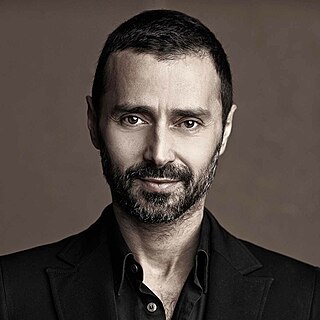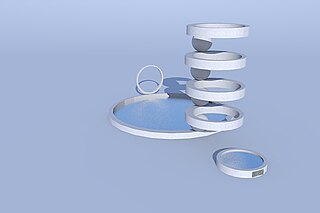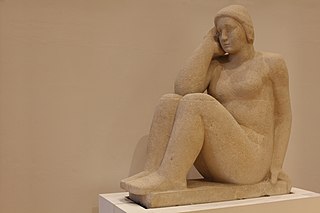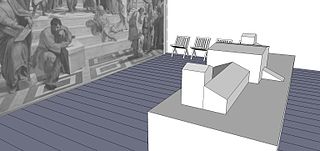This article needs additional citations for verification .(July 2010) (Learn how and when to remove this template message) |
 | |
| Established | 1923 |
|---|---|
| Location | Viale Alemagna 6, 20121, Milan, Italy |
| Coordinates | 45°28′21″N9°10′26″E / 45.4724°N 9.174°E Coordinates: 45°28′21″N9°10′26″E / 45.4724°N 9.174°E |
| Collections | Twentieth-century art |
| Director | Andrea Cancellato |
| Curator | Silvana Annacchiarico |
| Website | triennale |
The Triennale di Milano is a design and art museum in the Parco Sempione in Milan, in Lombardy in northern Italy. It is housed in the Palazzo dell'Arte, which was designed by Giovanni Muzio and built between 1931 and 1933; construction was financed by Antonio Bernocchi and his brothers Andrea and Michele. [1] :1948

Parco Sempione is a large city park in Milan, Italy. Established in 1888, it has an overall area of 38.6 hectares, and it is located in the historic centre of the city, inside the Zone 1 administrative division.

Milan is a city in northern Italy, capital of Lombardy, and the second-most populous city in Italy after Rome, with the city proper having a population of 1,395,274 while its metropolitan city has a population of 3,250,315. Its continuously built-up urban area has a population estimated to be about 5,270,000 over 1,891 square kilometres. The wider Milan metropolitan area, known as Greater Milan, is a polycentric metropolitan region that extends over central Lombardy and eastern Piedmont and which counts an estimated total population of 7.5 million, making it by far the largest metropolitan area in Italy and the 54th largest in the world. Milan served as capital of the Western Roman Empire from 286 to 402 and the Duchy of Milan during the medieval period and early modern age.

Lombardy is one of the twenty administrative regions of Italy, in the northwest of the country, with an area of 23,844 square kilometres (9,206 sq mi). About 10 million people, forming one-sixth of Italy's population, live in Lombardy and about a fifth of Italy's GDP is produced in the region, making it the most populous and richest region in the country and one of the richest regions in Europe. Milan, Lombardy's capital, is the second-largest city and the largest metropolitan area in Italy.
The Milan Triennial, an international exhibition of art and design, was held at the museum thirteen times between 1936 and 1996, [2] and – after a break of twenty years – again in 2016. [3]
The Milan Triennial was established in 1923 as a 3 yearly architecture and industrial design exhibition held in Monza and then, since 1933, in Milan.

A world's fair or world fair is a large international exhibition designed to showcase achievements of nations. These exhibitions vary in character and are held in different parts of the world at a specific site for a period of time, ranging usually from three to six months.
Since 2003 the Triennale has awarded the triennial Gold Medal for Italian Architecture (Italian : Medaglia d'oro all'architettura italiana). [4]
The Gold Medal for Italian Architecture, Italian: Medaglia d'oro all'architettura italiana, is a triennial Italian architecture prize. It has been awarded since 2003 by the Triennale di Milano in collaboration with the Ministero dei beni e delle attività culturali e del turismo, and with MADE expo, a trade fair for the construction industry.

Italian is a Romance language of the Indo-European language family. Italian descended from the Vulgar Latin of the Roman Empire and, together with Sardinian, is by most measures the closest language to it of the Romance languages. Italian is an official language in Italy, Switzerland, San Marino and Vatican City. It has an official minority status in western Istria. It formerly had official status in Albania, Malta, Monaco, Montenegro (Kotor) and Greece, and is generally understood in Corsica and Savoie. It also used to be an official language in the former Italian East Africa and Italian North Africa, where it still plays a significant role in various sectors. Italian is also spoken by large expatriate communities in the Americas and Australia. Italian is included under the languages covered by the European Charter for Regional or Minority languages in Bosnia and Herzegovina and in Romania, although Italian is neither a co-official nor a regional or a traditional language in these countries, where Italians do not represent a historical minority. In the case of Romania, Italian is listed by the Government along 10 other languages which supposedly receive a "general protection", but not between those which should be granted an "advanced or enhanced" one. Many speakers of Italian are native bilinguals of both Italian and other regional languages.
A permanent museum of Italian design, the Trienniale Design Museum, was opened in 2007. [5] :51
Italian design refers to all forms of design in Italy, including interior design, urban design, fashion design and architectural design. Italy is recognized as being a worldwide trendsetter and leader in design: the architect Luigi Caccia Dominioni claims that "Quite simply, we are the best" and that "We have more imagination, more culture, and are better mediators between the past and the future". Italy today still exerts a vast influence on urban design, industrial design and fashion design worldwide. Generally, the term "design" is associated with the age of the Industrial Revolution, which arrived in Italy during the pre-unification in the Kingdom of the Two Sicilies, in this context, was born on Italian design and development in various fields such as silks San Leucio and workshops Pietrarsa, shipyards of Castellammare di Stabia. The rest of Italy was characterized by fragmented political and geographical condition and the threshold of 1860 was farming and backward. After the Unification of Italy, despite the slow consolidation of the cotton industry and factories, the industrialization of the country was seldom talked about prior to 1870-80. At the beginning of the twentieth century formed the first great Italian designers such as Vittorio Ducrot and Ernesto Basile.
The building houses a theatre, the Teatro dell'Arte, which was also designed by Muzio. [5] :51
In 2019 the XXII Triennale was celebrated under the title "Broken Nature", focusing on design approaches that explore the relations between humans, nature and other species.
References
- ↑ Dario Marchesoni, Luisa Giussani (1985). La Triennale di Milano e il Palazzo dell'arte. Milan: Electra. ISBN 9788843511723.
- ↑ Milan Triennial Exhibition of Decorative Arts and Modern Architecture. Paris: Bureau International des Expositions. Archived 4 September 2011.
- ↑ 21st century. Design after Design. Paris: Bureau International des Expositions. Accessed November 2017.
- ↑ Luca Trombetta (16 December 2015). Un restauro che vale oro (in Italian). Corriere della Sera. Accessed February 2018.
- 1 2 Maria Grazia Bellisario Angela Tecce (2012). I luoghi del contemporaneo 2012 : contemporary art venues. Roma : Gangemi, 2012. ISBN 9788849224108.
![]()










